BAe Sea Harrier
- Details
- Category: Aircraft
- Published: Wednesday, 29 October 2008 00:00
- Written by Webmaster 1
- Hits: 48307
Type: Fleet air defence, strike and recon fighter with ASV role.
Versions in Service: Frs Mk.51 - Single-seat fighter
...........................T Mk.60 - Dual-seat trainer
Engine: One Rolls-Royce Pegasus Mk.104/106 vectored-thrust turbofan, rated at 95.6kN (21,500 lbs.) of thrust.
Operational Speed: 640 knots (1186 km/h).
Service Ceiling: 51,200 feet (15,600 meters).
Range: 800 nautical miles (1480 km).
Avionics: Fitted with the Ferranti Blue Fox non-coherent pulse radar, which has four operating modes - search, air-to-air, air-to-surface and bore-sight for close combat.
Weapons: The aircraft has four wing and three under-fuselage stations. The inner wing pylons carry drop tanks of 900 kg each. The two outer wing pylons can carry up to 450 kg each. Two under-fuselage stations are normally occupied by two 30mm gun pods, with 120 rounds per gun. Indian Navy Sea Harriers use Magic-IIs for air defense. In the anti-ship role, the Sea Harrier can carry two Sea Eagle AShMs.
Maximum External Stores Load: STOL (Short Take-Off & Landing) mode - 3629 kg (8000 lbs).
..........................................VTOL (Vertical Take-Off & Landing) mode - 2268 kg (5000 lbs).
Self Defence: Fitted with a Marconi ARI-18223 radar warning receiver. Some aircraft have been recently been refitted with the Roshni RWR, which is the naval variant of the indigenously-developed Tarang Mk.II RWR.
Aircraft delivered to date: IN601 - Mk.51 (05 Oct 1984) - air accident on 04 May 1988
...................................IN602 - Mk.51 (12 July 1984)
...................................IN603 - Mk.51 (13 Dec 1983)
...................................IN604 - Mk.51 (13 Dec 1983)
...................................IN605 - Mk.51 (13 Dec 1983)
...................................IN606 - Mk.51 (12 July 1984)
...................................IN607 - Mk.51 (24 July 1990)
...................................IN608 - Mk.51 (14 Dec 1989)
...................................IN609 - Mk.51 (10 Apr 1990)
...................................IN610 - Mk.51 (14 Dec 1989)
...................................IN611 - Mk.51 (14 Dec 1989) - air accident on 30 September 1997
...................................IN612 - Mk.51 (10 Apr 1990) - air accident on 09 December 1992
...................................IN613 - Mk.51 (24 July 1990)
...................................IN614 - Mk.51 (24 July 1990)
...................................IN615 - Mk.51 (23 Apr 1991)
...................................IN616 - Mk.51 (17 Sept 1991)
...................................IN617 - Mk.51 (17 Sept 1991)
...................................IN618 - Mk.51 (23 Apr 1991)
...................................IN619 - Mk.51 (23 Apr 1991) - air accident on 09 June 1992
...................................IN620 - Mk.51 (17 Sept 1991) - air accident on 08 February 1996
...................................IN621 - Mk.51 (17 Sept 1991) - beyond economical repair
...................................IN622 - Mk.51 (14 Jan 1992)
...................................IN623 - Mk.51 (07 Apr 1992)
...................................IN651 - T Mk.60 (15 Mar 1984)
...................................IN652 - T Mk.60 (16 Mar 1984) - air accident on 27 June 1988
...................................IN653 - T Mk.60 (10 Apr 1990)
...................................IN654 - T Mk.60 (14 Jan 1992)
...................................IN655 - T Mk.60 (2003) - T Mk.4(I) upgraded to T Mk.60 standard
...................................IN656 - T Mk.60 (2003) - T Mk.4(I) upgraded to T Mk.60 standard
Note: Known Sea Harrier air accidents include twelve Mk.51 single-seaters and a pair of T Mk.60 trainers. IN621 is beyond economical repair due to a bad landing and lies on static display at Goa Museum. The dates of seven Sea Harrier air accidents have been listed above, while the remaining seven are listed below, due to a lack of reliable information on the corresponding serial number;
• IN65? - T Mk.60: 02 August 1994
• IN6?? - Mk.51: 23 November 1998
• IN6?? - Mk.51: 25 May 2001
• IN6?? - Mk.51: 24 August 2003
• IN6?? - Mk.51: 16 December 2004 - extensive damage, possible write-off.
• IN6?? - Mk.51: 05 December 2005
• IN6?? - Mk.51: 24 December 2007
Not all air accidents result in the aircraft being withdrawn from active service. On occasion, depending on the severity of the crash, the aircraft could be repaired and see active service once again. In some cases, the aircraft is stripped of all usable components before being discarded or being put on static display as occurred with IN621.
Comments: The Sea Harriers fly with the INAS 300 and INAS 552 squadrons, the latter being a training unit for rookie pilots. The Sea Harrier Operational Flying Training (SHOFTU) was formed as part of INAS 300 on 16 April 1990. In 1991, SHOFTU was conjoined as a separate flight into the existing INAS 551 squadron, which flies HAL Kiran Mk.II aircraft. Subsequently, a separate squadron - INAS 552 - was raised on 07 July 2005 for the purpose of ab-initio training on the Sea Harrier. Fourteen single-seat and four dual seat aircraft currently serve with the two squadrons. The dual-seat trainers include two remaining T Mk.60s from the first batch and two ex-RAF T Mk.4 trainers, modified to the T Mk.60 standard despite airframe differences. The dual-seat trainer has the complete avionics systems of the single-seat fighter, apart from the Ferranti 'Blue Fox' radar. Due to the larger length of both trainer variants, they have to be placed diagonally on the hangar elevator of INS Viraat.
At the commissioning ceremony of the INAS 552 squadron, Rear Admiral Shekhar Sinha, Flag Officer Commanding Naval Aviation, stated that the Sea Harrier would be phased out by 2012 or at the latest by 2015. In an interesting twist of events, Flight Global reported on 29 November 2007 that the Indian Navy was planning to go ahead with a limited upgrade of its Sea Harriers, which is to be completed by 2008 and is expected to extend the life of the aircraft by 15 years. This would indicate a retirement date of 2023, which is more than 11 - 12 years after the retirement date indicated by Rear Admiral Shekhar Sinha. The upgrade is expected to refit the aircraft with advanced sensors, radars and avionics and is to be performed by Bangalore-based Hindustan Aeronautics Limited (HAL).
The Indian Navy launched Project Ashok in Kochi, in 1994, which serves a maintenance facility for the Sea Harriers. Earlier Sea Harriers had previously been taken to the U.K. for overhaul after they were acquired in the mid-1980s. Established for Rs.3 billion ($7.14 million), the facility is expected to keep the Sea Harriers operational till they retire. A large proportion of Project Ashok's facilities are generic and capable of servicing other aircraft, such as the MiG-29K. There are nine facilities set up under the project and the major ones at Kochi include landing gear & hydraulics, environmental control systems, structural repairs, power generator, avionics, Pegasus engine test bed and Pegasus engine repair and overhaul. Named after late Captain Ashok Sawhney, a pioneering air engineer, Project Ashok is a fitting tribute to this visionary who built up the Naval Aircraft Yard at Kochi.
In July 1999, a mid-life upgrade package worth $200 million was reportedly announced by the Indian Navy. Afterwards this upgrade package was cancelled in favour of purchasing the MiG-29K air defense fighter, for deployment on the Vikramaditya (formerly Admiral Gorshkov) and the Air Defence Ship. It was planed that the Sea Harriers would retire by 2010 along with the decommissioning of aircraft carrier INS Viraat in the same year. Surprisingly in March 2005, the Cabinet Committee on Security (CCS) cleared the upgradation of 14 Sea Harriers. Defence Minister Pranab Mukherjee stated that the aircraft will be upgraded at a cost of Rs 476.69 crore and will be carried out by the Hindustan Aeronautics Limited (HAL) in Bangalore. He also stated that the upgradation will involve the installation of new radars (Elta EL/M-2032 multimode fire control radar), new air-to-air missiles (Derby BVRAAM) from Israeli firm Rafael, combat manoeuvring flight recorders and digital cockpit voice recorders.
A formal contract, worth $25 million, was signed with the Rafael Armament Development Authority in February 2005 for the Derby BVRAAM and includes an initial batch of 20 missiles and six training rounds. Under the proposed contract, officials from Rafael will be stationed at the Sea Harrier base in Goa to train Navy personnel on the operation & maintenance of the missiles and will also supply trolleys and racks to load & handle the missiles. Delivery of the missiles are expected to begin 30 months after the signing of the contract and will be completed within one year thereafter.

![A beautiful shot of a Mk.51 [IN 617] in flight. This aircraft is from the second-last batch of seven aircraft delivered in September 1991. Image © BAe Systems via Jon Lake](/NAVY/images/aviation/Harrier7_small.jpg)
![The Indian Navy's first Sea Harrier [IN601] on delivery through Malta. Circa October 1984. The aircraft was lost in an air accident on 04 May 1988. Image © Gary Vincent](/NAVY/images/aviation/Harrier23_small.jpg)
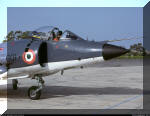
![The first Sea Harrier Mk.51 [IN 601] at the Farnborough Air Show in England in September 1982. Notice the Sea Eagle AShM at extreme right. IN 601 crashed on 04 May 1988. Image © Air Nikon via Airliners.Net](/NAVY/images/aviation/Harrier13_small.jpg)
![IN608 [Cougar] served in both static & flying display roles at Aero India 2005. The Cougar - along with IN607 [Simba], IN613 [Lion] and IN6XX [Puma] - have been temporarily transferred to INAS 551B Squadron, which serves as a traning unit for SHAR pilots. Image © Simon Watson](/NAVY/images/aviation/Harrier18_small.jpg)

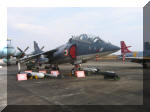

![This two-seater T Mk.4 trainer [IN651] night stopped in Malta while on delivery to the Indian Navy. This photo was taken on 27 March 1984. Image © Joseph Tonna](/NAVY/images/aviation/Harrier27_small.jpg)
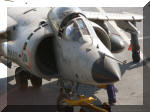

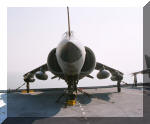
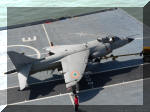
![The first two-seater Sea Harrier [IN651] in Indian Navy service, is seen here onboard INS Viraat on 08 Jan 2006. Image © Kapil Chandni](/NAVY/images/aviation/Harrier15_small.jpg)

![Of the first two T Mk.60 trainers [IN651 and IN652] purchased in 1984, the second one was lost in an air accident in 1988. Image © Kapil Chandni](/NAVY/images/aviation/Harrier33_small.jpg)
![Sea Harrier T Mk.60 [IN651]. Image © Kapil Chandni](/NAVY/images/aviation/Harrier32_small.jpg)

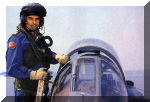


![A pair of Mk.51s [IN 606 and IN 603] aboard INS Viraat, being serviced by ship's personnel. Image © Indian Navy](/NAVY/images/aviation/Harrier3_small.jpg)
![A Sea Harrier Frs Mk.51 [IN 611] is guided for take off aboard INS Viraat. IN 611 crashed on 30 September 1997. Image © Indian Navy via Kapil Chandni](/NAVY/images/aviation/Harrier20_small.jpg)
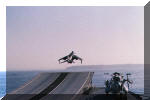

![A four-ship Mk.51 [IN 603, IN 604, IN 606 and IN 602] formation in flight. Image © Indian Navy](/NAVY/images/aviation/Harrier9_small.jpg)



![A pair of Mk.51s [IN 610 and IN 604] and a T Mk.60 [IN 65?] at Dabolim, Goa. Image © Indian Navy](/NAVY/images/aviation/Harrier6_small.jpg)